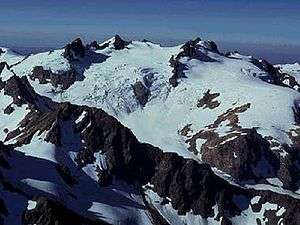Mount Olympus (Washington)
Mount Olympus, at 7,980 feet, is the tallest and most prominent mountain in the Olympic Mountains of western Washington state. Located on the Olympic Peninsula, it is also the central feature of Olympic National Park. Mount Olympus is the highest summit of the Olympic Mountains; however, peaks such as Mount Constance, on the eastern margin of the range, are better known, being visible from the Seattle metropolitan area.
| Mount Olympus | |
|---|---|
 | |
| Highest point | |
| Elevation | 7,980 ft (2,432 m) NAVD 88[1] |
| Prominence | 7,838 ft (2,389 m) [2] |
| Listing |
|
| Coordinates | 47°48′05″N 123°42′39″W [1] |
| Geography | |
 Mount Olympus Washington | |
| Location | Olympic National Park, Jefferson County, Washington, US |
| Parent range | Olympic Mountains |
| Topo map | USGS Mount Olympus |
| Geology | |
| Age of rock | Eocene |
| Mountain type | Shale and sandstone |
| Climbing | |
| First ascent | 1907 by L.A. Nelson and party[3] |
| Easiest route | Glacier Climb |
Description
With notable local relief, Mount Olympus ascends over 2,100 m (6,900 ft) from the 293 m (961 ft) elevation confluence of the Hoh River with Glacier Creek in only 8.8 km (5.5 mi). Mount Olympus has 2,386 m (7,828 ft) of prominence, ranking 5th in the state of Washington.[4]
Due to heavy winter snowfalls, Mount Olympus supports large glaciers, despite its modest elevation and relatively low latitude. These glaciers include Blue, Hoh, Humes, Jeffers, Hubert, Black Glacier, and White, the longest of which is the Hoh Glacier at 3.06 miles (4.93 km). The largest is Blue with a volume of 0.14 cubic miles (0.57 km3) and area of 2.05 square miles (5.31 km2).[5] As with most temperate latitude glaciers,[6] these have all been shrinking in area and volume, and shortening in recent decades.
History
The local Native American name for the peak is Sunh-a-do,[7] and upon sighting in 1774 by the Spanish explorer Juan Pérez, the mountain was named Cerro Nevado de Santa Rosalía ("Snowy Peak of Saint Rosalia"). This is said to be the first time a European named a geographic feature in what is now Washington state. In 1788, on July 4, the British explorer John Meares gave the mountain its present name.[8]
In 1890 an expedition, led by US Army officer Joseph P. O'Neil, reached the summit, of what is today presumed to have been the southern peak.[9]
On March 2, 1909, Mount Olympus National Monument was proclaimed by President Theodore Roosevelt.[10] On June 28, 1938, it was designated a national park by President Franklin D. Roosevelt.[11] In 1976 the Olympic National Park became an International Biosphere Reserve. In 1981 it was designated a World Heritage Site.[12] In 1988 Congress designated 95% of the park as the Olympic Wilderness.
Climate
Mt Olympus peak has a tundra climate (ET) with extremely heavy precipitation from October to April and heavy precipitation from May to September. A large part of this precipitation falls as snow. Mt Olympus west peak is the wettest place in mainland USA.
| Climate data for Mt Olympus west peak | |||||||||||||
|---|---|---|---|---|---|---|---|---|---|---|---|---|---|
| Month | Jan | Feb | Mar | Apr | May | Jun | Jul | Aug | Sep | Oct | Nov | Dec | Year |
| Average high °F (°C) | 28.6 (−1.9) |
30.0 (−1.1) |
32.6 (0.3) |
37.7 (3.2) |
43.4 (6.3) |
48.8 (9.3) |
56.1 (13.4) |
57.5 (14.2) |
52.9 (11.6) |
41.8 (5.4) |
32.7 (0.4) |
28.4 (−2.0) |
40.9 (4.9) |
| Daily mean °F (°C) | 24.0 (−4.4) |
24.5 (−4.2) |
25.4 (−3.7) |
29.5 (−1.4) |
35.1 (1.7) |
41.0 (5.0) |
47.6 (8.7) |
48.6 (9.2) |
44.6 (7.0) |
35.3 (1.8) |
27.6 (−2.4) |
23.6 (−4.7) |
33.9 (1.1) |
| Average low °F (°C) | 19.4 (−7.0) |
19.1 (−7.2) |
18.2 (−7.7) |
21.3 (−5.9) |
26.7 (−2.9) |
33.2 (0.7) |
39.0 (3.9) |
39.6 (4.2) |
36.3 (2.4) |
28.9 (−1.7) |
22.6 (−5.2) |
18.9 (−7.3) |
26.9 (−2.8) |
| Average precipitation inches (mm) | 41.66 (1,058) |
26.00 (660) |
27.73 (704) |
21.70 (551) |
11.16 (283) |
9.97 (253) |
4.72 (120) |
5.81 (148) |
8.82 (224) |
22.81 (579) |
39.49 (1,003) |
39.25 (997) |
259.12 (6,580) |
| Source: [13] | |||||||||||||
See also
References
- "Mt Olympus". NGS data sheet. U.S. National Geodetic Survey. Retrieved 2009-01-11.
- "Mount Olympus, Washington". Peakbagger.com. Retrieved 2009-01-01.
- Olympic Mountain Rescue (Society) (1988). Climber's Guide to the Olympic Mountains (3rd ed.). Seattle: Mountaineers Books. p. 163. ISBN 978-0-89886-154-9.
- "All Washington Peaks with 2000 Feet of Prominence". Jeff Howbert. Archived from the original on 2008-05-15.
- Spicer, Richard C. (1986). Glaciers in the Olympic Mountains, Washington: Present Distribution and Recent Variations. Thesis. University of Washington.
- "Glaciers and Climate Change". Olympic National Park. National Park Service.
- "Mount Olympus: Historical Background". SummitPost.org. May 20, 2015. Retrieved June 1, 2015.
- Phillips, James W. (1971). Washington State Place Names. University of Washington Press. ISBN 0-295-95158-3.
- "Members of the Olympic Exploring Expedition make first recorded ascent of Mount Olympus on September 22, 1890." www.historylink.org, accessed 26. January 2019
- "Mount Olympus National Monument" (PDF). Retrieved 2015-03-14.
- "Timeline of the Elwha Through 1940". Olympic National Park. National Park Service. Retrieved 2015-03-14.
- "Your Heritage, Celebrating 75 Years". Olympic National Park. National Park Service. Retrieved 2015-03-14.
- https://prism.oregonstate.edu/explorer/
External links
| Wikimedia Commons has media related to Mount Olympus, Washington. |
- "Mount Olympus". SummitPost.org.
- "Mount Olympus". Bivouac.com.
- "Mount Olympus". Peakware.com. Archived from the original on 2016-03-04.
- The Mountaineers: 1920 Outing to Mt. Olympus - University of Washington Library
- The Mountaineers Photography - University of Washington Library
